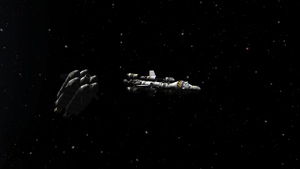Difference between revisions of "Tutorial:How to get to Eve"
m |
|||
| Line 1: | Line 1: | ||
{{outdated}} | {{outdated}} | ||
| − | {{Box|type=error|This article does not address any of the aerodynamics and heating changes introduced since official release (1.0).}} | + | {{Box|type=error|This article does not address any of the aerodynamics and heating changes introduced since official release (1.0). Attempting a Kerbin-style landing on Eve will almost guarantee failure.}} |
[[File:Eve map.png|thumb|225px|right|Eve. If you don't see this at some point during the tutorial, you've probably done it incorrectly.]] | [[File:Eve map.png|thumb|225px|right|Eve. If you don't see this at some point during the tutorial, you've probably done it incorrectly.]] | ||
Revision as of 07:03, 20 July 2015
| This page or section is in need of being brought up to date. Please help Kerbal Space Program Wiki by fixing inaccurate or outdated information. |
Contents
Traveling to Eve
Eve is Kerbin's closest neighbor, and therefore is the easiest to reach. Yet returning from Eve is much more difficult due to Eve's powerful gravity and thick atmosphere. If you are a experienced player and rather brave you may want the tutorial for Returning from Eve.
Specifications
- Length: 1–3 hours
- Difficulty: Moderate/Hard
- For version: .17
Additionally, you will need a good understanding of orbital mechanics (see Tutorials section), angles, and a lot of patience.
Steps
Step 1 - Build Your Rocket
To perform a successful landing on Eve you will need a large space ship. You could either launch it with one enormous rocket in one go, or you could launch the middle- and upper stage into orbit with separate launches, and then dock them together in orbit.
Upper Stage
Only consider building an upper stage if you want to perform a landing. It should consist of, at the very least, a lander that can touch down on the surface. You may also want to consider packing some extra fuel, in case either:
A. Your middle stage can't pull you out of Eve's orbit.
B. You want it to be capable of flying back to orbit for a return mission.
If you want to land, you will not need as many parachutes as you would for a landing on Kerbin due to a thicker atmosphere. You may want to consider landing rockets just in case you lose your chute. If you are seriously planning on going home, you will need very large rockets for this stage.
Middle Stage
This is the stage you will be using to fly from Kerbin's orbit to Eve's, and possibly to decelerate into controlled descent. It's recommended this stage remain light, so thrusters with a high specific impulse, such as the LV-909 Liquid Fuel Engine or ideally, nuclear engines, are recommended for the journey.
Lower Stage
This stage should take you at least into Kerbin's orbit if you hope to reach Eve. It will require several large thrusters to lift the interplanetary vehicle itself into orbit, probably assisted by some SRBs.
Step 2 - Planetary Alignment
While not absolutely essential, the easiest and fastest way to reach Eve from Kerbin is ensuring that they are properly aligned. Otherwise, you may spend a lot of time (possibly years) and fuel drifting until they happen to match up.
To do so, check your map and make sure that Eve is behind Kerbin in its orbit around Kerbol, and if you were to draw a line from Eve to Kerbol to Kerbin, it would form a ~60 degree angle. From this angle, you can get to a height of 200 km around Kerbin, orbit retrograde until Eve is directly behind Kerbin, and burn until you have reached a velocity of roughly 3000 m/s for a direct path to Eve.
Alternatively, you can visit The Interplanetary Guide and Calculator to calculate your own path.
Step 3 - Launch to Kerbin Orbit
Take off as usual into an eastward orbit (see Tutorials for how to achieve orbit). Unless you've done your own calculations, try to aim for a circular equatorial orbit at around 200,000 meters.
Step 4 - Fly from Kerbin to Eve
If you have successfully reached your desired orbit around Kerbin, begin your high-velocity burn. Keep an eye on your map, as mentioned above you will need to wait until Kerbin sits exactly between you and Eve, and get your velocity up to approximately 3060 m/s.
It's really important to watch the map while you are accelerating. As you accelerate your Kerbolar orbital path should move to intersect Eve's. If all goes well, there should be a brief moment where you are captured by Eve's gravity well right around the target velocity. Immediately cut your thrust. If you overshoot, just turn the craft around and do a slight retro burn until you are caught again.
This journey should take about 200+ days, so hit the warp key and enjoy the ride.
Step 5 - Arriving at Eve
When you enter Eve's sphere of influence you will almost certainly be travelling at escape velocity. If you have the fuel, simply burn retrograde at periapsis until you are in some kind of orbit.
You can greatly reduce the amount of fuel required to achieve an orbit around Eve by aerobraking. As shown on the information page, Eve's atmosphere begins around 100 km, so if you pass Eve with a periapsis slightly lower than that, the atmosphere will bleed off some speed before you retro burn in to an orbit.
You can continue to lower your orbit with aerobraking by keeping your periapsis slightly below 100 km. If you are not planning on landing, execute a prograde burn at apoapsis to raise your periapsis above the atmosphere once your apoapsis is low enough. Unless you have escape velocity or an extremely wide orbit, going below 95 km will probably result in an unplanned descent.
Step 6 - Land on Eve (Optional)
Adjust your orbital path to where you would like to land, and continue aerobraking to bleed off that extra velocity. Eventually you will be caught on a terminal descent through the atmosphere. You will notice that due to the thicker and larger atmosphere than Kerbin's you will descend much more slowly. Deploy your chute(s) to slow down even further. Lower whatever landing gear you brought with you and fire retrorockets if the chutes aren't slowing you down enough. Ultimately we're going for a typical touchdown speed (6–12 m/s).
Congratulations! You've landed on Eve!

